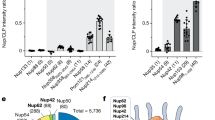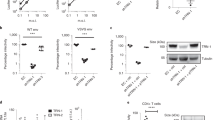Abstract
It is recognized that HIV-1 capsid cores are disassembled in the cytoplasm, releasing their genomes into the nucleus through nuclear pores, but there is also evidence showing the capsid (CA) exists in the nucleus. Whether HIV-1 enters the nucleus and how it enters the nucleus through the undersized nuclear pore remains mysterious. Based on multicolor labeling and real-time imaging of the viral and cellular components, our observations via light and electron microscopy suggest that HIV-1 selectively gathered at the microtubule organization center (MTOC), leading the nearby nuclear envelope (NE) to undergo deformation, invagination and restoration to form a nuclear vesicle in which the viral particles were wrapped; then, the inner membrane of the nuclear vesicle ruptured to release HIV-1 into the nucleus. This unexpected discovery expands our understanding of the complexity of HIV-1 nuclear entry, which may provide new insights to HIV-1 virology.
Similar content being viewed by others
References
Achuthan, V., Perreira, J.M., Sowd, G.A., Puray-Chavez, M., McDougall, W.M., Paulucci-Holthauzen, A., Wu, X., Fadel, H.J., Poeschla, E.M., Multani, A.S., et al. 2018. Capsid-CPSF6 interaction licenses nuclear HIV-1 trafficking to sites of viral DNA integration. Cell Host Microbe, 24: 392–404.e8.
Arii, J., Watanabe, M., Maeda, F., Tokai-Nishizumi, N., Chihara, T., Miura, M., Maruzuru, Y., Koyanagi, N., Kato, A., and Kawaguchi, Y. (2018). ESCRT-III mediates budding across the inner nuclear membrane and regulates its integrity. Nat Commun 9, 3379.
Beaudouin, J., Gerlich, D., Daigle, N., Eils, R., and Ellenberg, J. 2002. Nuclear envelope breakdown proceeds by microtubule-induced tearing of the lamina. Cell, 108: 83–96.
Burdick, R.C., Li, C., Munshi, M.H., Rawson, J.M.O., Nagashima, K., Hu, W.S., and Pathak, V.K. 2020. HIV-1 uncoats in the nucleus near sites of integration. Proc Natl Acad Sci USA, 117: 5486–5493.
Campbell, E.M., and Hope, T.J. 2015. HIV-1 capsid: the multifaceted key player in HIV-1 infection. Nat Rev Microbiol, 13: 471–483.
de Noronha, C.M.C., Sherman, M.P., Lin, H.W., Cavrois, M.V., Moir, R.D., Goldman, R.D., and Greene, W.C. 2001. Dynamic disruptions in nuclear envelope architecture and integrity induced by HIV-1 Vpr. Science, 294: 1105–1108.
Dharan, A., and Campbell, E.M. 2018. Role of microtubules and microtubule-associated proteins in HIV-1 infection. J Virol, 92: e00085.
Du Toit, A. 2018. Maximizing delivery. Nat Rev Microbiol, 16: 582–583.
Elia, N., Sougrat, R., Spurlin, T.A., Hurley, J.H., and Lippincott-Schwartz, J. 2011. Dynamics of endosomal sorting complex required for transport (ESCRT) machinery during cytokinesis and its role in abscission. Proc Natl Acad Sci USA, 108: 4846–4851.
Francis, A.C., and Melikyan, G.B. 2018. Single HIV-1 imaging reveals progression of infection through CA-dependent steps of docking at the nuclear pore, uncoating, and nuclear transport. Cell Host Microbe, 23: 536–548.e6.
Ganser-Pornillos, B.K., Cheng, A., and Yeager, M. 2007. Structure of full-length HIV-1 CA: a model for the mature capsid lattice. Cell, 131: 70–79.
Harding, S.M., Benci, J.L., Irianto, J., Discher, D.E., Minn, A.J., and Greenberg, R.A. 2017. Mitotic progression following DNA damage enables pattern recognition within micronuclei. Nature, 548: 466–470.
Hatch, E.M. 2018. Nuclear envelope rupture: little holes, big openings. Curr Opin Cell Biol, 52: 66–72.
Hatch, E.M., Fischer, A.H., Deerinck, T.J., and Hetzer, M.W. 2013. Catastrophic nuclear envelope collapse in cancer cell micronuclei. Cell, 154: 47–60.
Johnson, D.S., Bleck, M., and Simon, S.M. 2018. Timing of ESCRT-III protein recruitment and membrane scission during HIV-1 assembly. eLife, 7: e36221.
Lahaye, X., Gentili, M., Silvin, A., Conrad, C., Picard, L., Jouve, M., Zueva, E., Maurin, M., Nadalin, F., Knott, G.J., et al. 2018. NONO detects the nuclear HIV capsid to promote cGAS-mediated innate immune activation. Cell, 175: 488–501.e22.
Leeks, A., Sanjuán, R., and West, S.A. 2019. The evolution of collective infectious units in viruses. Virus Res, 265: 94–101.
Lowe, A.R., Siegel, J.J., Kalab, P., Siu, M., Weis, K., and Liphardt, J.T. 2010. Selectivity mechanism of the nuclear pore complex characterized by single cargo tracking. Nature, 467: 600–603.
Ma, Y., He, Z., Tan, T., Li, W., Zhang, Z., Song, S., Zhang, X., Hu, Q., Zhou, P., Wu, Y., et al. 2016. Real-time imaging of single HIV-1 disassembly with multicolor viral particles. ACS Nano, 10: 6273–6282.
MacKenzie, K.J., Carroll, P., Martin, C.A., Murina, O., Fluteau, A., Simpson, D.J., Olova, N., Sutcliffe, H., Rainger, J.K., Leitch, A., et al. 2017. cGAS surveillance of micronuclei links genome instability to innate immunity. Nature, 548: 461–465.
McDonald, D., Vodicka, M.A., Lucero, G., Svitkina, T.M., Borisy, G.G., Emerman, M., and Hope, T.J. 2002. Visualization of the intracellular behavior of HIV in living cells. J Cell Biol, 159: 441–452.
Morita, E., Sandrin, V., McCullough, J., Katsuyama, A., Baci Hamilton, I., and Sundquist, W.I. 2011. ESCRT-III protein requirements for HIV-1 budding. Cell Host Microbe, 9: 235–242.
Ohkawa, T., and Welch, M.D. 2018. Baculovirus actin-based motility drives nuclear envelope disruption and nuclear egress. Curr Biol, 28: 2153–2159.e4.
Panté, N., and Kann, M. 2002. Nuclear pore complex is able to transport macromolecules with diameters of ∼39 nm. Mol Biol Cell, 13: 425–434.
Peng, K., Muranyi, W., Glass, B., Laketa, V., Yant, S.R., Tsai, L., Cihlar, T., Müller, B., and Kräusslich, H.G. 2014. Quantitative microscopy of functional HIV post-entry complexes reveals association of replication with the viral capsid. eLife, 3: e04114.
Raab, M., Gentili, M., de Belly, H., Thiam, H.R., Vargas, P., Jimenez, A.J., Lautenschlaeger, F., Voituriez, R., Lennon-Duménil, A.M., Manel, N., et al. 2016. ESCRT III repairs nuclear envelope ruptures during cell migration to limit DNA damage and cell death. Science, 352: 359–362.
Salina, D., Bodoor, K., Eckley, D.M., Schroer, T.A., Rattner, J.B., and Burke, B. 2002. Cytoplasmic dynein as a facilitator of nuclear envelope breakdown. Cell, 108: 97–107.
Santiana, M., Ghosh, S., Ho, B.A., Rajasekaran, V., Du, W.L., Mutsafi, Y., De Jésus-Diaz, D.A., Sosnovtsev, S.V., Levenson, E.A., Parra, G.I., et al. 2018. Vesicle-cloaked virus clusters are optimal units for interorganismal viral transmission. Cell Host Microbe, 24: 208–220.e8.
Segura-Totten, M., and Wilson, K.L. 2001. Virology. HIV—breaking the rules for nuclear entry. Science, 294: 1016–1017.
Shah, P., Wolf, K., and Lammerding, J. (2017). Bursting the bubble—nuclear envelope rupture as a path to genomic instability? Trends Cell Biol 27, 546–555.
Sowd, G.A., Serrao, E., Wang, H., Wang, W., Fadel, H.J., Poeschla, E.M., and Engelman, A.N. 2016. A critical role for alternative polyadenylation factor CPSF6 in targeting HIV-1 integration to transcriptionally active chromatin. Proc Natl Acad Sci USA, 113: E1054–E1063.
Speese, S.D., Ashley, J., Jokhi, V., Nunnari, J., Barria, R., Li, Y., Ataman, B., Koon, A., Chang, Y.T., Li, Q., et al. 2012. Nuclear envelope budding enables large ribonucleoprotein particle export during synaptic Wnt signaling. Cell, 149: 832–846.
Turan, A., Grosche, L., Krawczyk, A., Mühl-Zürbes, P., Drassner, C., Düthorn, A., Kummer, M., Hasenberg, M., Voortmann, S., Jastrow, H., et al. 2019. Autophagic degradation of lamins facilitates the nuclear egress of herpes simplex virus type 1. J Cell Biol, 218: 508–523.
Turgay, Y., Champion, L., Balazs, C., Held, M., Toso, A., Gerlich, D.W., Meraldi, P., and Kutay, U. 2014. SUN proteins facilitate the removal of membranes from chromatin during nuclear envelope breakdown. J Cell Biol, 204: 1099–1109.
Acknowledgements
We would like to thank the Center for Biological Imaging (CBI), IBP-CAS, particularly Shuoguo Li, Yun Feng and Can Peng, for technical support with the SIM and TEM work. This work was supported by the Strategic Priority Research Program of the Chinese Academy of Sciences (XDB29050100).
Author information
Authors and Affiliations
Corresponding authors
Ethics declarations
Compliance and ethics The author(s) declare that they have no conflict of interest.
Rights and permissions
About this article
Cite this article
Li, X., Wang, D., Cui, Z. et al. HIV-1 viral cores enter the nucleus collectively through the nuclear endocytosis-like pathway. Sci. China Life Sci. 64, 66–76 (2021). https://doi.org/10.1007/s11427-020-1716-x
Received:
Accepted:
Published:
Issue Date:
DOI: https://doi.org/10.1007/s11427-020-1716-x




